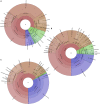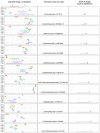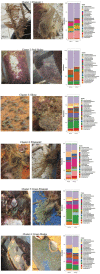Microbial Composition and Variability of Natural Marine Planktonic and Biofouling Communities From the Bay of Bengal
- PMID: 31866960
- PMCID: PMC6908470
- DOI: 10.3389/fmicb.2019.02738
Microbial Composition and Variability of Natural Marine Planktonic and Biofouling Communities From the Bay of Bengal
Abstract
The Bay of Bengal (BoB) is the largest bay in the world and presents a unique marine environment that is subjected to severe weather, a distinct hydrographic regime and a large anthropogenic footprint. Despite these features and the BoB's overall economic significance, this ecosystem and its microbiome remain among the most underexplored in the world. In this study, amplicon-based microbial profiling was used to assess the bacterial, archaeal, and micro-eukaryotic content of unperturbed planktonic and biofilm/biofouling communities within the BoB. Planktonic microbial communities were collected during the Southwest monsoon season from surface (2 m), subsurface (75 m), and deep-sea (1000 m) waters from six south-central BoB locations and were compared to concomitant mature biofouling communities from photic-zone subsurface moorings (∼75 m). The results demonstrated vertical stratification of all planktonic communities with geographic variations disappearing in the deep-sea environment. Planktonic microbial diversity was found to be driven by different members of the community, with the most dominant phylotypes driving the diversity of the photic zone and rarer species playing a more influential role within the deep-sea. Geographic variability was not observed in the co-located biofouling microbiomes, but community composition and variability was found to be driven by depth and the presence of macro-fouling and photosynthetic organisms. Overall, these results provide much needed baselines for longitudinal assessments that can be used to monitor the health and evolution of this dynamic and critically important marine environment.
Keywords: marine biofilm; microbiome; microfouling; planktonic; rRNA.
Copyright © 2019 Angelova, Ellis, Wijesekera and Vora.
Figures






Similar articles
-
Phylogenetic diversity and functional potential of the microbial communities along the Bay of Bengal coast.Sci Rep. 2023 Sep 25;13(1):15976. doi: 10.1038/s41598-023-43306-4. Sci Rep. 2023. PMID: 37749192 Free PMC article.
-
Depth-Differentiation and Seasonality of Planktonic Microbial Assemblages in the Monterey Bay Upwelling System.Front Microbiol. 2020 May 25;11:1075. doi: 10.3389/fmicb.2020.01075. eCollection 2020. Front Microbiol. 2020. PMID: 32523584 Free PMC article.
-
Diversity, structure, and distribution of bacterioplankton and diazotroph communities in the Bay of Bengal during the winter monsoon.Front Microbiol. 2022 Nov 30;13:987462. doi: 10.3389/fmicb.2022.987462. eCollection 2022. Front Microbiol. 2022. PMID: 36532434 Free PMC article.
-
Strong Seasonality in Arctic Estuarine Microbial Food Webs.Front Microbiol. 2019 Nov 29;10:2628. doi: 10.3389/fmicb.2019.02628. eCollection 2019. Front Microbiol. 2019. PMID: 31849850 Free PMC article. Review.
-
The oceans are changing: impact of ocean warming and acidification on biofouling communities.Biofouling. 2019 May;35(5):585-595. doi: 10.1080/08927014.2019.1624727. Epub 2019 Jul 8. Biofouling. 2019. PMID: 31282218 Review.
Cited by
-
Phylogenetic diversity and functional potential of the microbial communities along the Bay of Bengal coast.Sci Rep. 2023 Sep 25;13(1):15976. doi: 10.1038/s41598-023-43306-4. Sci Rep. 2023. PMID: 37749192 Free PMC article.
-
Ways to control harmful biofilms: prevention, inhibition, and eradication.Crit Rev Microbiol. 2021 Feb;47(1):57-78. doi: 10.1080/1040841X.2020.1842325. Epub 2020 Dec 28. Crit Rev Microbiol. 2021. PMID: 33356690 Free PMC article. Review.
-
Unveiling the Antifouling Performance of Different Marine Surfaces and Their Effect on the Development and Structure of Cyanobacterial Biofilms.Microorganisms. 2021 May 20;9(5):1102. doi: 10.3390/microorganisms9051102. Microorganisms. 2021. PMID: 34065462 Free PMC article.
-
Phylogenetic diversity and functional potential of large and cell-associated viruses in the Bay of Bengal.mSphere. 2023 Dec 20;8(6):e0040723. doi: 10.1128/msphere.00407-23. Epub 2023 Oct 30. mSphere. 2023. PMID: 37902318 Free PMC article.
-
Sulphate-reducing bacterial community structure from produced water of the Periquito and Galo de Campina onshore oilfields in Brazil.Sci Rep. 2021 Oct 13;11(1):20311. doi: 10.1038/s41598-021-99196-x. Sci Rep. 2021. PMID: 34645885 Free PMC article.
References
-
- Andrews S. (2010). FastQC: A Quality Control Tool for High Throughput Sequence Data. Available at: http://www.bioinformatics.babraham.ac.uk./projects/fastqc/ (accessed October 6, 2011).
-
- Asmus R. M., Sprung M., Asmus H. (2000). Nutrient fluxes in intertidal communities of a South European lagoon (Ria Formosa) - Similarities and differences with a northern Wadden Sea bay (Sylt-Rømø Bay). Hydrobiologia 436 217–235. 10.1023/A:1026542621512 - DOI
-
- Behera B. C., Mishra R. R., Dutta S. K., Thatoi H. N. (2014). Sulphur oxidising bacteria in mangrove ecosystem: a review. Afr. J. Biotechnol. 13 2897–2907. 10.5897/AJB2013.13327 - DOI
LinkOut - more resources
Full Text Sources

